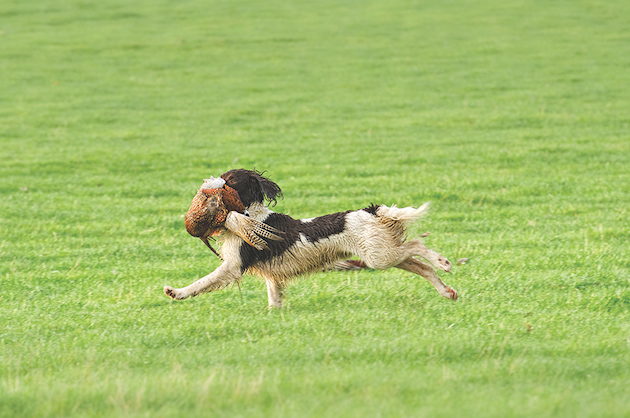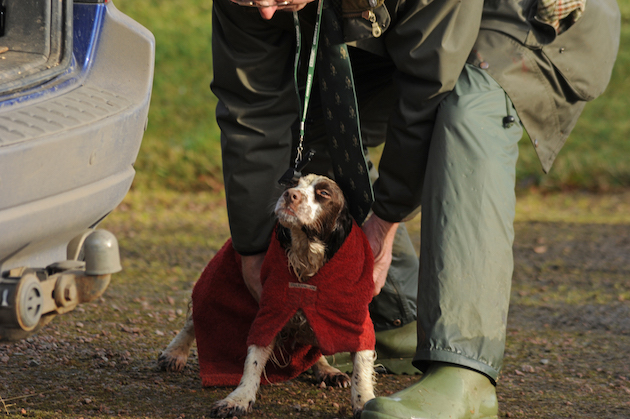Win CENS ProFlex DX5 earplugs worth £1,149 – enter here
Six rules for caring for your gundog after a shoot day
Tony looks at ways of keeping a hard-working gun dog happy during the season.
 An english springer spaniel retrieving a shot cock pheasant
An english springer spaniel retrieving a shot cock pheasant
Caring for your gundog is a priority after a day in the field. Your four-legged working colleague will have given his all, sat patiently on the peg, plunged resolutely into ponds, headed into deep cover. So he will be happy but exhausted.
We’re frequently asked how to prepare a dog for a shoot day but it’s equally important to ensure that his welfare is taken care of afterwards too. You want to keep your gundog in the best condition, to maintain enthusiasm, fitness, health and guard against joint problems. Here’s how to do it.

Always dry your dog off carefully
Caring for your gundog after a shoot day
- Think about how your gundog will be transported to the shoot and home again. Dog boxes are useful because they keep the animal safely in the back of the car and prevent the car’s interior becoming muddy and wet.
- Think about the dog’s comfort before your own. Don’t rush off to warm yourself by a roaring fire in the pub on the way home while your dogs are left wet and cold, in the back of the car. Make sure they are dried off with a towel and can keep warm. The best way to do this is by putting plenty of shredded (unprinted) paper in the dog box. I also take an old sack stuffed with clean, dry paper with me which means I can provide the dog with a nice, dry bed at the end of the day’s shooting. If you know it’s going to be a wet day, take a spare bag with you. You can then take out the wet bedding and stuff it in the bag before creating a new bed in the box for the drive home. (Read this article on hypothermia in dogs.)
You could use straw or some other type of bedding, but be wary of leaving towels or blankets that a younger dog may decide to chew – if unsupervised they could choke. I tend not to use straw, even though it’s natural and cheaper, as I’ve found in the past barley straw gives my dog lice. Don’t rely on the paper (or any bedding for that matter) to dry off a dog before taking it on a long journey. I always carry a large towel to dry off the dog before putting it in the box. A coat is also useful to keep a dog warm (read are dog coats really necessary.) Take a look at our list of best dog coats. - Remember to carry a plentiful supply of clean drinking water, and a large, non-spill drinker in the car so you can give the dog a drink. Always deter a dog from taking from puddles or still water. Speaking from experience, to see a dog die from Leptospirosis – spread by rats urine – is not a pleasant event. Although every responsible dog owner will have their dogs vaccinated against Leptospirosis, it does seem that this vaccination is now becoming less effective at protecting our dogs against this common disease. (Read why you shouldn’t let your dog drink from puddles.)
- As the weather gets colder it’s worth remembering that a dog will use up 40% of its daily food intake just to keep its body temperature stable. So think about increasing its nourishment. During the shooting season I always find it an advantage to feed some type of flesh to a dog that’s working really hard. We use minced tripe, and give, say, around half to one pound a day to a dog, along with a small amount of a good quality complete food. At this point there’s a word of warning about ‘complete’ foods that are high in protein and fat content – by this I mean 30% + protein and 15% + oil content. Although these foods are generally good quality, they do tend to make some dogs very active. This can mean that the dog will often be what most people consider ‘over active’ for up to the first hour of work – and then be so blown as to be virtually unable to work thereafter! Another problem I’ve encountered with this type of food is that it can make some spaniels hyperactive in the kennel, the result being you can’t hold any weight on the dog under any circumstances.
- Consider some form of heating in the dog’s kennel. If the dog has been working hard all day it can lose an enormous amount of body heat overnight. We use what I call an infra-red ‘pig lamp.’ These units are readily available from a local farmers’ co-op and usually have either a red or a white lamp fitted (you can also buy the unit with an ’emitter,’ which gives off heat but no light). These ‘heat lamps’ will keep your dog sufficiently warm overnight, and can help prevent the animal from waking in the morning with stiff joints.
- For kennel bedding we use shredded paper, mainly because it can be disposed of relatively easily. Alternatively you could use one of those manufactured dog blankets, or vet beds, which are made from a sort of imitation wool. These are good and pretty effective, but not always ideal as most dogs enjoy having a good scrape and rummage before settling down. As a consequence, a dog often tends to ruck-up this type of blanket bedding into a lump in the corner of the kennel – and then ends up lying predominantly on the floor rather than the bedding! (Take a look at this guide to the best gun dog beds.)
This piece was originally published in 2014 and has been updated.
Related Articles
Get the latest news delivered direct to your door
Subscribe to Shooting Times & Country
Discover the ultimate companion for field sports enthusiasts with Shooting Times & Country Magazine, the UK’s leading weekly publication that has been at the forefront of shooting culture since 1882. Subscribers gain access to expert tips, comprehensive gear reviews, seasonal advice and a vibrant community of like-minded shooters.
Save on shop price when you subscribe with weekly issues featuring in-depth articles on gundog training, exclusive member offers and access to the digital back issue library. A Shooting Times & Country subscription is more than a magazine, don’t just read about the countryside; immerse yourself in its most authoritative and engaging publication.







